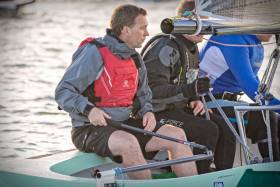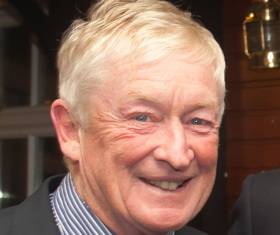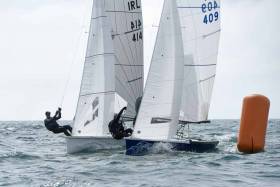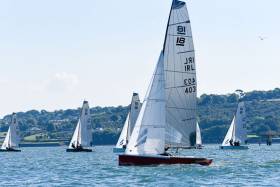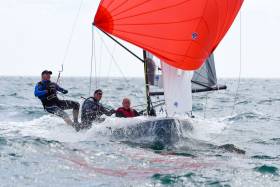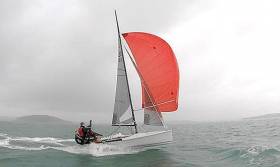Displaying items by tag: National 18
Royal Cork National 18 Season Concludes with Light Air Crews Race
Last Friday evening saw the last races of the National 18 season that consisted of two races in front of Royal Cork Yacht Club and with buoys at the rear of the RCYC marina for an unusual course configuration on the Owenabue river in light winds and officiated by race officer Tommy Dwyer.
The evening also served as the National 18 crews race with some familiar faces in some unfamiliar roles. Tom Crosbie was sailing a borrowed boat as he had sold his beloved 'The Good Wife'. RCYC General Manager Gavin Deane was also helming an entry as was forthcoming Junior All Ireland finalist, Chris Bateman.
Scroll down for photo gallery below by Bob Bateman
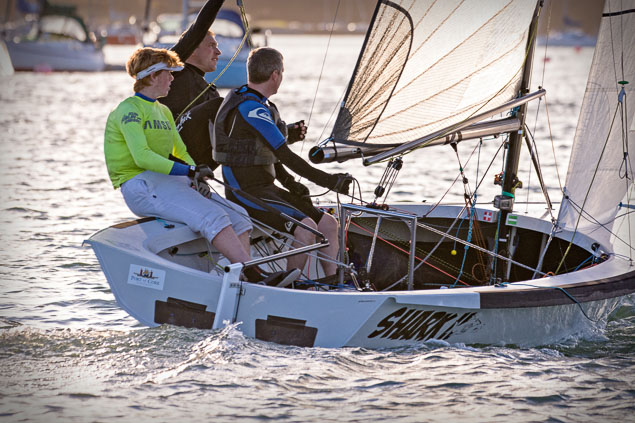

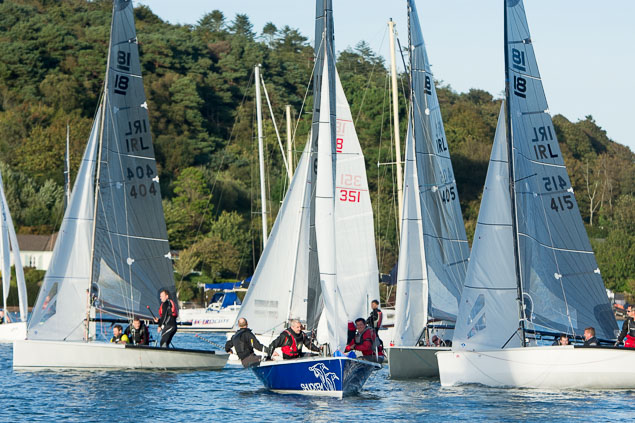
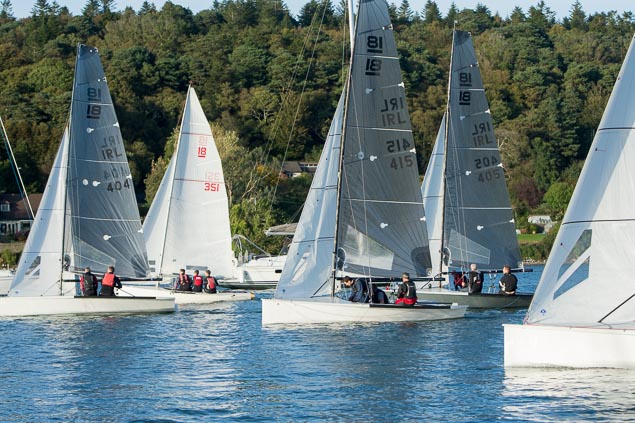
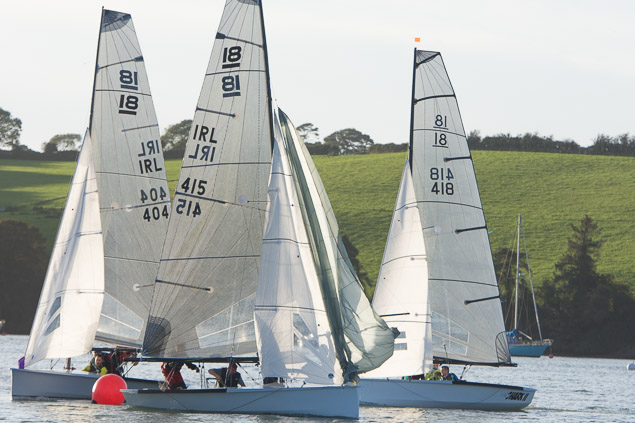
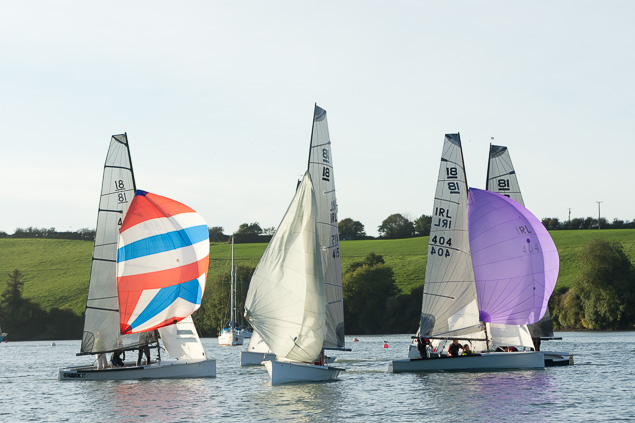
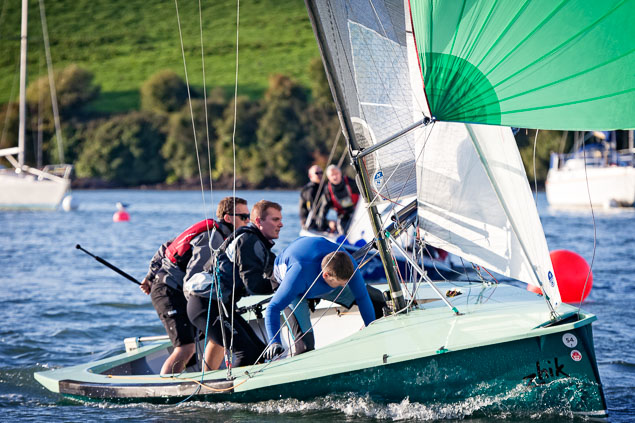


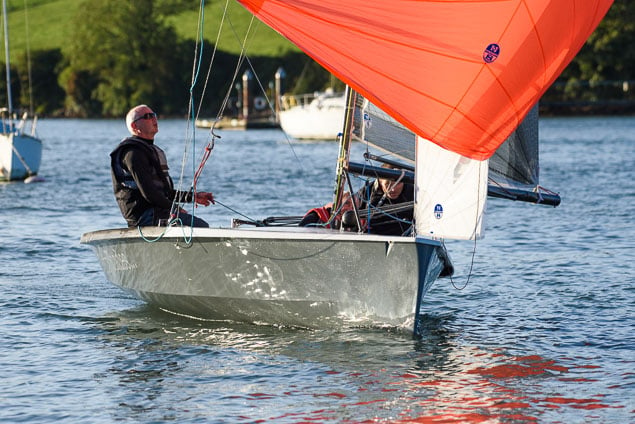
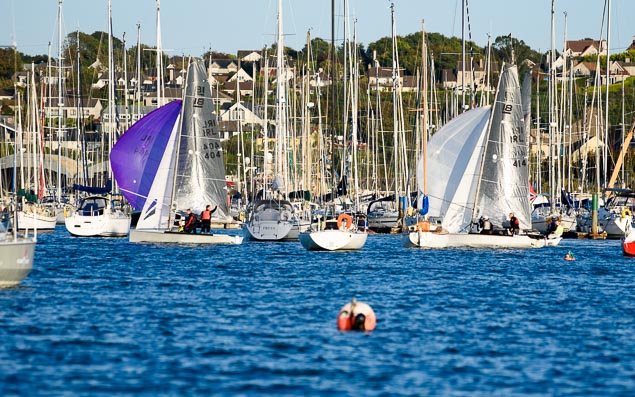
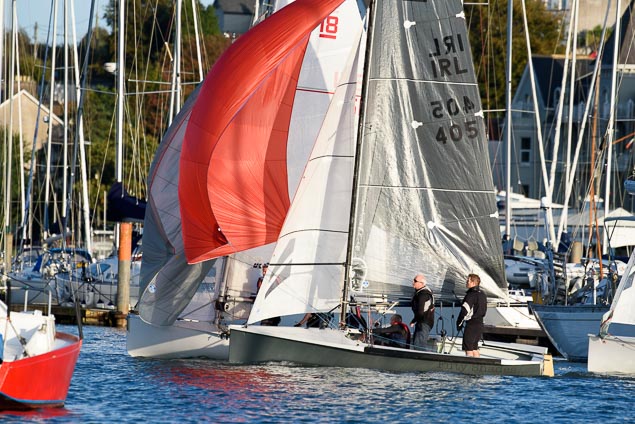
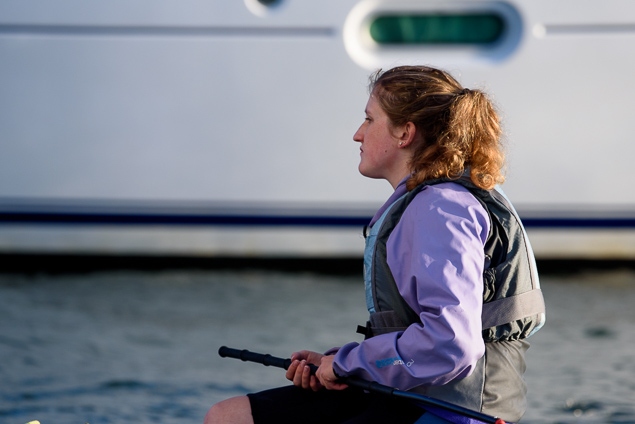
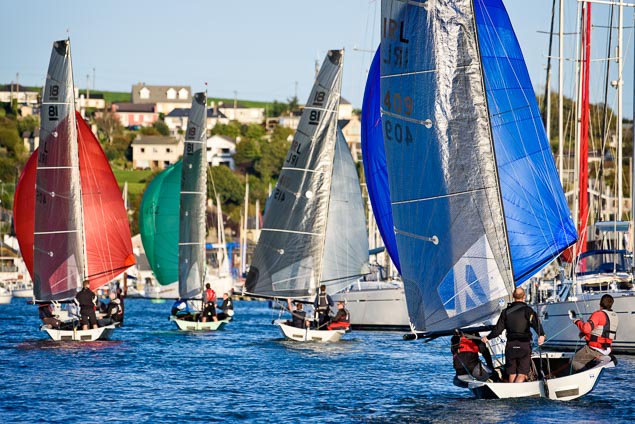
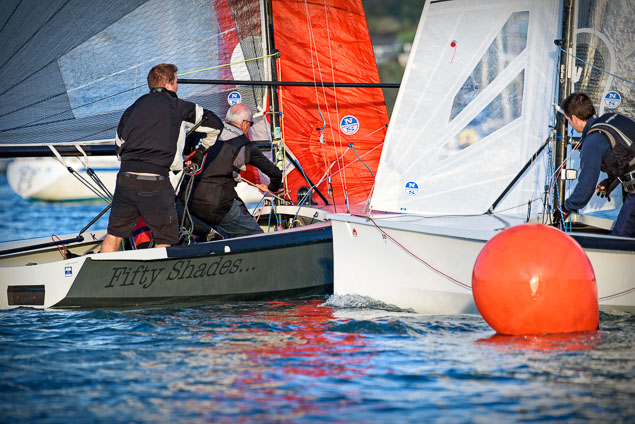
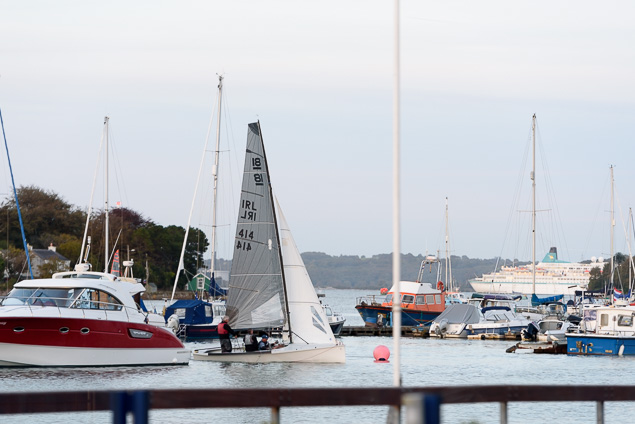

As announced at the recent National 18 Championships, the Cork N18 class are hosting a big party in the Royal Cork Yacht Club on Saturday, 9th September in recognition of Dom Long's 35 years of service to the class.
This will be run in conjunction with the Sutton Book event with guests from Sutton Dinghy Club racing N18's for the day.
There will be plenty of on the water action both sail and power along with a function in the club on Sat evening.
Dwyer Reigns at National 18 Easterns at Howth Yacht Club
Six relatively light wind races completed at Howth Yacht Club gave Charles Dwyer and his crew Nin O'Leary and Richie the overall win of the inaugural six–boat National 18s Eastern Championships in Dwyer's new boat.
A tie break behind them saw Tommy Dwyer, Peter O'Donovan and Charlie Moloney take second with Colin Chapman, Morgan O'Sullivan and Ronan Walsh taking third.
The National 18s continue racing in Cork Harbour with Wednesday leagues already in operation and Saturday racing beginning at the start of May.
No sooner has Howth Yacht Club completed its Spring Warmer Series for keelboats than it is preparing for its first dinghy event of the 2017 Summer season. HYC will host the RS Eastern Championship over the 22nd April and 23rd April.
The RS classes will be joined by Cork Harbour's travelling National 18s and the SB20 sportsboat class.
In the run up to the championships, the RS Feva class are staging a two day training session in Howth. Training is open to all sailors around the country regardless of ability. 20 boats are expected for the Easterns and there is a lot of renewed interest in the class now from Optimist sailors looking to try a two hander.
An early bird entry discount has been extended until tomorrow (April 12), according to HYC's Ross MacDonald. Enter here.
Royal Cork's National 18 Will Be On Display & Racing At Southampton Boat Show 2016
After a successful Irish National Championships this month at Royal Cork Yacht Club, the National 18 Class Association is exhibiting the new Morrison designed National 18 (known as the Ultra) at the Southampton Boat Show from 16 to 25 September 2016.
The National 18 class has undergone a hugely successful period of change and development over the last two years and is now taking a breather and enjoying learning how to get the best out of sailing the fantastic new boats. This means that after two full seasons the boats have been fully tested and developed to meet all the expectations and requirements of the Class members and no more changes are planned in the foreseeable future.
Since the Phil Morrison designed hull was adopted in July 2014, sixteen boats have been built, two more are underway, and a new sail plan has been introduced incorporating a laminate square top mainsail and 21sq m spinnaker, along with twin spinnaker poles. Fifteen Ultras took part in the 2016 National Championship held at Findhorn near Inverness and produced incredibly close and hugely enjoyable racing.
On show at Stand A106 in the Arena will be 'The Shadow' (412) from Blackwater Sailing Club, whilst two National 18s will race in the 'Battle of the Classes' on Sunday 25 September.
The National 18 is available from the Class builder, White Formula of Brightlingsea, at an on-the-water sail away package price of £16,995 including VAT.
The Morrison designed National 18 has, as intended by the Class, created a performance three-person dinghy with one trapeze that is fast and capable of being handled by crews of varying ability, age, and experience; she is not an extreme boat and many people commented that she looks a "proper boat."
The National 18s are renowned for their companionship and great social scene both and on and off the water, as well as for outstanding high performance racing; the Autumn is an ideal time to place an order with the builders to have your new boat ready in good time for next year's racing programme and for the National Eighteen Championships which are to be held at Hayling Island Sailing Club in August 2017.
For further information about the National 18 ClassThe original idea was that of Frank Knowling of Whitstable YC (later to be known as the father of the class) for an 18-foot sailing dinghy, suitable for day sailing, yet fast enough to be of interest to racing sailors and at a reasonable cost. (The first rather hopeful restriction of the original class rules was "Price not to exceed £125 complete with spars, all equipment and designer's fee but not including sails"). The plan was to produce an affordable national alternative to the many local one-designs of about this size to be found right round the coast of the British Isles. Many of these local estuary classes survive today, for example the Mermaid in Dublin, Thames Estuary OD, Chichester Harbour 18 etc.
The well-known designer Uffa Fox won the competition (over the Laurent Giles submitted version) with his 'Ace' design for a clinker-built wooden boat. National 18' number 1, 'Hurricane', was owned by Stanley Beale and sailed at Whitstable, with No.2 'Gust' and No.3 Foam''.
Initial enthusiasm was held back by the effects of World War II but a good deal of 18' building got underway soon afterwards, when mahogany was again available for boat-building and the class became active especially in the Thames Estuary area. By 1950, fleets had appeared at clubs dotted all around the British Isles and Ireland, the Class Association having been formed in 1947.
Although most boats were built to the 'Ace' design, the class had always been 'restricted' rather than 'one-design' and boats with a reduced number of wider planks were built when glued plywood construction was adopted and even one moulded carvel boat was built (252 'Sabon').
Several of the wooden 18's, now called 'Classics' are still in commission, and regularly race, principally at Bosham SC. They include No15 Tinkerbell, built in 1938 and still very competitive.
With the advent of GRP and the rising costs of hard woods, the Class asked Ian Proctor in the late '60's to design a fibreglass hull that would not outclass the existing boats. In this he was successful and it was some time before a Proctor hull won the championships. The first new Proctor, 'Genivieve' was exhibited at the Crystal Palace Dinghy Show of 1970 when a bare hull cost £153. Since then the Class has progressively reduced minimum hull and centreboard weight, and introduced a single trapeze. Also a restriction which requires all new hulls to come from the class mould so they are in effect one-design. Rigs have been optimised and more recently carbon spars introduced.
These changes produced a boat known in the Class as an 'Ultimate' which is fast and exciting to sail and which has provided close and competitive racing for fifteen or so years, both locally and at the annual National Championships. The Royal Cork Yacht Club has the largest fleet.
The class strives to be inclusive in providing heathy competition for all generations of 18s through handicaps and separate starts. Thus though the major trophies at National Championships are awarded in the Ultimate class, there are trophies also for the Pen-ultimates (heavy GRP) and the Classics.
In 2012 the class mould was declared unservicable, and there was much debate about what to do next. This culminated in a request to Phil Morrison to design a hull that was sleeker, lighter, faster and safer, and in so far as reasonably possible within the existing measurement restrictions.
The Morrison prototype was financed by supporters of the Class and built at The Boatyard at Bere in 2013. Named 'Odyssey' and trialled extensively, she ticks all the boxes, is a pleasure to sail and has proved a great success. This development will undoubtedly give the Class a new lease of life, and production of new boats is already under way at White Formula in Brightlingsea.
Irish Sailing Association Seeks Nominees for Junior & All Ireland Sailing Championships
The Irish Sailing Association is inviting class associations to make nominations for the ISA All Ireland Sailing Championship and ISA All Ireland Junior Sailing Championships 2016.
The ISA All Ireland Junior Sailing Championships on September 24th – 25th at Fastnet Marine & Outdoor Education Centre, Schull, Co. Cork. The event will be sailed in FMOEC TR 4.2 class two person dinghies.
The ISA All Ireland Sailing Championship on October 1st – 2nd at Royal Cork Yacht Club, Crosshaven, Co. Cork. The event will be sailed in National 18 three person dinghies.
The ISA is seeking three nominations from each of the senior classes. The junior and youth classes will be advised on the number of places allocated for that class as per notice of race. Nominations will be only accepted from classes whose affiliation fee is paid for 2016.
Class associations are also invited to suggest candidates for a wild card place; these would be members who have excelled at an International competition in the class during the year.
The age limit for the Junior Sailing Championships is under 19 years on December 31, 2016. If a class holds a junior/youth national championship for eligible sailors they may nominate to the Junior championship in the same way and enclosing a copy of the relevant Notice of Race. Please see the Notice of Race for both events below.
The ISA says its policy of a National Race Officer managing racing at a class’s national championship will be strictly applied.
The deadline for nominations is: ISA All Ireland Junior Sailing Championship is 1500hrs on the 12th of September, 2016 and 1500hrs on the 19th of September for the ISA All Ireland Sailing Championships
National 18 dinghy D’Good, D’Bad and D’Blaster sailed by Ewen Barry, Stanley Browne and Dion Barrett was the winner of the nine boat Ultra division of the Irish class championships at Royal Cork YC on six points after five races sailed. Three points behind Second was Aquadisiacs skippered by Colin Chapman with Morgan O’Sullivan and Aaron Walsh with 50 Shades (Nick Walsh, Rob Brownlow and Eddie Rice) third.
Four boats raced in the Ultimate division, with Stephen O'Shaughnessy's Virtual Reality
At an Extraordinary General Meeting held at the Royal Cork Yacht Club on Saturday 27 February, the National 18 Class voted in a number of rule changes that modernise the mainsail for the new Morrison designed 18 and increase the spinnaker size for the class too.
The changes complete a modernisation process that began at the National 18 AGM in Findhorn in 2012, after which Phil Morrison was asked to design a new hull, a prototype was funded by members of the class and then extensively trialed.
The new design was approved in July 2014 and White Formula appointed as builder in the autumn of that year. The first boat was completed in time for the 2015 RYA Suzuki Dinghy Show and eleven new boats were on the water by the time of the 2015 National Championship. As well as enjoying great class racing the new National 18s have been putting in some excellent results at multi-class events, including great results in the GJW Direct SailJuice Winter Series 2015/16.
For the 2016 season at least 17 of the new Morrison boats will be racing and the introduction of the updated mainsail and spinnaker for this season will further enhance an already very successful new design. The new mainsail incorporates a broad head and laminate materials with a full length top batten. The new spinnaker is increased in overall size by 25%, bringing it to 21 sq metres total, and in addition twin spinnaker pole systems will be allowed.
The National 18 will be on show again at the 2016 edition of the RYA Suzuki Dinghy show, which takes place on Saturday 5 and Sunday 6 March. The boat to be displayed on on stand B36 is a brand new build for Julian Berney of Blackwater Sailing Club, which will be formally named at the show at 14.30 on Saturday afternoon.
If you are visiting the show do come along and take a look at this latest addition to the National 18 Class and speak with a member of the fleet about the boats and the opportunities for trial sailing and purchase. A limited number of new boats are still available for delivery for the 2016 Championship which will be held at Findhorn, Scotland, from 1 to 5 August. The price for a new "ready to race" National 18 is £16,995 including VAT and those placing orders at the RYA Suzuki Dingy Show will receive a free trolley with colour matched bunks.
National 18s to Vote on Class Changes at EGM in Royal Cork
The National 18 dinghy class will hold an extraordinary general meeting on Saturday, 27th February at Royal Cork Yacht Club to vote on three new proposals for the three man centreboarder.
The first proposal seeks approval to allow Morrison division National 18’s to carry mainsail aligned to modern design and construction materials. The new mainsail can be made in either Dacron or HMPE/aramid fibre laminate.
Full details of the egm are carried in a notice downloadable below.
Ireland’s Boats & People – How Do We Get Them Together?
The recently-published ISA Survey of Club Racing commissioned and supervised by Board Member Jack Roy has started the process of putting together a realistic picture of how we sail and go afloat for recreation, and it was analysed on publication here in Afloat.ie.
It’s logical to have made the beginning with club racing, as racing provides its own narrative and a straightforward set of entry numbers and results. But it will become more complex as the national authority tries to provide realistic figures for day sailing’s less competitive aspects. And of course, once we enter the world of cruising as defined by sailing and boating projects which include passage making, both coastal and offshore, together with overnight on-board stops, then it can become much more difficult to get meaningful data.
Yet with the ISA’s Cruising Conference for February 20th already booked out within a few days of being announced on Afloat.ie, clearly that is an area in search of services and support, a section of sailing which is difficult to quantify yet obviously of strong interest to a significant number of boat enthusiasts. W M Nixon takes a look at how the complexity of our sport’s many specialities makes it difficult to provide a clearcut picture for possible recruits to sailing.
Where would we be without the International Optimist Dinghy? The little solo-sailing boxes and their attendant support teams of mum and dad and the dog and the old 4X4 or station wagon or people carrier or whatever may seem to take up an awful lot of space and time, and all just so that one little person can go sailing.
But at least that one little person does go sailing. The ISA figures are brutally straightforward. In terms of genuine turnouts afloat at clubs throughout Ireland, in boat numbers the active Optimists are exceeded only by the Lasers, and this is arguably because Lasers aren’t age-limited, whereas the Optimists most definitely are.

Optimist airborne. This is Ireland's second most popular class
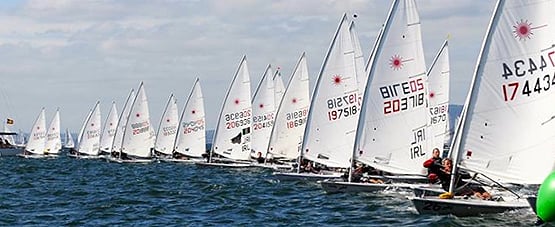
Ireland’s most popular dinghy class, the Laser is seen here at the Zhik Irish Nationals at Ballyholme
So we give a qualified cheer for the success of these two little boats. But it’s qualified because they’re single-handers which fail to provide any crew-relating sailing skills. Leading sailing figures as diverse as Des McWilliam of Crosshaven and Norman Lee of Greystones have been eloquent in promoting the notion that we should be doing more – much more – to encourage two-handed boats, and if we can persuade people into three-handed boats, well, so much the better.
Certainly that’s one of the reasons why our header photo says so much. A lone sailor in an Optimist or Laser promotes too much of a solitary, even an isolated image. And a two-handed boat like the GP 14, whose strong fleet figures in the ISA survey show the class’s vigour, is arguably just an act for a dynamic duo – it’s Strictly Come Dancing goes sailing…..
But getting three together to race a characterful boat like the National 18 with style – now that’s something special, that really is a superb combination of people skills interacting with sailing talent. And it’s a joy to behold. Yet anyone can see that for a complete beginner to sailing, this extraordinary silhouette of Tommy Dwyer’s National 18 against the November sky above the Hill of Howth will have an otherworldly air about it – “That’s not for me” is as likely a response as “Let’s have a go at that”.
Even those of us who have been in sailing for longer than we care to remember find the image decidedly thought-provoking, for we have some idea of what has been involved in creating the circumstances for this seemingly effortless balancing act, this lighter-than-air effect in the unlikely setting of a November afternoon.
Over the past year or so we have been recounting in Afloat,ie how the Cork Harbour National 18 Class, with very tangible backing from the Royal Cork Yacht Club, have been in the forefront of the development of the new ground-breaking Phil Morrison take on the long-established National 18, which is a developmental class which from time to time takes a leap in hull design, and moves forward in order to keep the spirit alive.
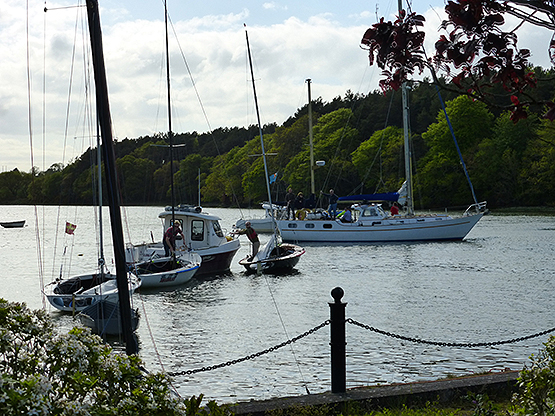
The National 18s are part of the fabric of Cork Harbour sailing. Before the new Morrison boats arrived in July, the old fleet were seen here in May 2015 after their annual race to Ballinacurra in northeast Cork Harbour in company with the Dwyer brothers’ cruising ketch. Photo: W M Nixon
Acceptance of this is something which seems to be bred into Cork’s National 18 enthusiasts, many of whom have the advantage of being firmly of the opinion that a proper dinghy needs three people to sail it. But the social matrix which has built up around Cork Harbour over many decades with this concept at its heart is not something which will necessarily travel easily to other areas, and although the six boats of the National 18 flotilla which visited Howth for the Open Day got a great reception and gave many people from other classes a marvellous time afloat, it’s probable that the very different mood around sailing in Dublin means that something so technically and socially challenging as a three man dinghy is a step too far.
Sailing in the greater Dublin area seems to exist within a framework of independent balloons. While there are those who will happily move from one boat type to another and cheerfully spread their talents and enjoyment about, by contrast there’s the Dublin Bay Sailing Club Thursday Evening Phenomenon.
Thursday is when the DBSC cruiser classes go out to race. And there’s an entire cohort of people, mostly folk who work in offices in the city, who on a Thursday evening go straight to Dun Laoghaire, get aboard a pontoon-based cruiser owned by someone else, go out and race in some very specific crewing job, then come back in and have supper in club or pub with their shipmates, and then that’s it until next Thursday. Just one evening each summer mid-week is their entire sailing programme. Weekends are for something else. And as for the hassle and mixed joys of boat ownership and maintenance, that’s not their department at all.
It’s a very metropolitan, very citified yet specialized way of doing things, and Dublin is one of the very few cities whose location facilitates it. It will be fascinating to measure it, for Dublin’s way of sailing is steeped in history and tradition. But for now it’s refreshing to look at a place which has had a sailing tradition in times past, but somehow lost it, yet it’s coming back again, and one of the good news stories towards the end of 2015 is that the new Youghal Sailing Club has been accepted into the ISA fold.
Youghal at present is a difficult place for sailing, as the tidal power of the mighty Munster Blackwater sweeps straight through the estuary and along the old town’s waterfront, and the creation of any meaningful modern facilities will have the immediate difficulty of silting by incredibly adhesive black mud.

With the sun out, and the tide in, Youghal looks to be an ideal location for the easy installation of a marina….....Photo: W M Nixon
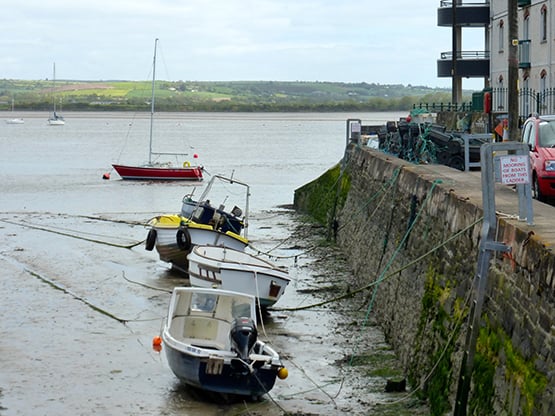
….but with the sun in and the tide out, the mud problem is revealed. Photo: W M Nixon
Thus, as dedicated Afloat.ie readers will have recently observed, no sooner had one group announced that a marina in Youghal was on the way than another longer-established group quietly suppressed the story, as they’re well aware of the engineering and dredging difficulties involved, and premature announcements will only slow any project in the long run.
In the fullness of time, a marina at Youghal will be a godsend for any cruiser plugging along the south coast. It’s not always the easiest coast in the world to make a passage along, sometimes it can seem an awfully long way to Cork from Dunmore East or Kilmore Quay even if you do make stopovers at Dungarvan or Helvick, and there are times when the hardiest seafarer is glad enough to get his boat secured to a good big pontoon.
But that’s for the future. Meantime, the locally-based keelboats are using either the restless anchorage off the town, or the more serene pool across the estuary at Ferry Point on the east shore, while the new club’s flotilla of GP 14s are stored in spare warehouse space during non-sailing time, and when they do go sailing it turns out their clubhouse is a moveable feast - it’s a caravan which can be towed to a choice of sailing locations.
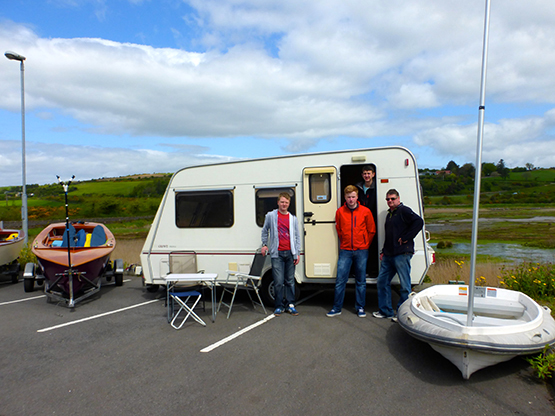
A moveable feast. Members of the newly-affiliated Youghal Sailing Club with their caravan HQ, Adrian Lee in doorway. Photo: W M Nixon
On the national stage, it is young Youghal GP 14 sailor Adrian Lee who has been among those flying the club’s flag, and there’s hope in the air. When we were there in May on a fine day that promised a summer which never arrived, we couldn’t help but think that when they do get their facilities and maybe even a clubhouse, they’ll look back to the days of the caravan and ad hoc racing arrangements with sweet nostalgia. For sometimes, it’s much better to be travelling than it is to arrive.
But for the rest of us, the message from Youghal is simple. The sea is for sailing. Use it or lose it. By all means get proper people surveys done which indicate the way numbers are shaping up and things are going. But really, if you want to persuade people to go sailing, the best way is by example, getting afloat as much as possible yourself. And maybe then you’ll find the time to welcome aboard newcomers too.

Reviving Youghal sailing – on race days, the club’s caravan is simply towed down to the pier and the races are started from there. Photo: W M Nixon
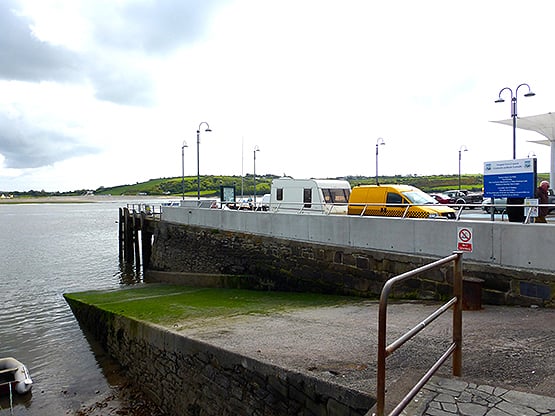
Youghal’s massive public slip provides launching for the YSC sailing dinghies, but during 2015 the boats had to be stored at the other end of town when not in use. Photo: W M Nixon
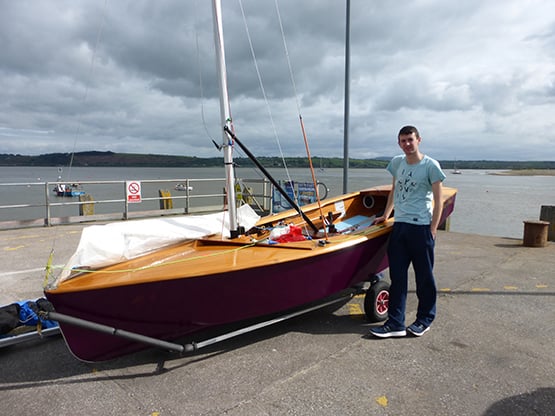
The pace-setter. Adrian Lee of Youghal SC with his Duffin-built GP14. Photo: W M Nixon
Click to download: ISA Survey of Club Racing



























